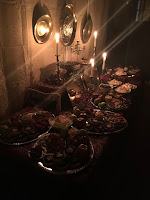 |
| Final course on the sideboard Photo by Isabel Maria |
A friend wanted to host a Christmas event with a meal (Southron Gaard, Festa de Natale, December 2018). He wanted a menu suitable for his Lady’s persona, i.e. late 1570’s Italian noblewoman. I chose to follow Scappi, a chef to various cardinals and pope’s, whose Opera dell'arte del cucinare was published in 1570.
I used Scappi’s recipes and menus to construct a feasibly accurate light summer celebration meal for Italy in the 1570’s.
Design, Materials and Construction:
I reviewed all the translated menus from Scappi I could find, and established the appropriate number of courses and dishes for a light feast. I reviewed the dishes on those menus, and arranged them as to the appropriate course in which they should appear (certain dishes appear only in certain courses). From those lists I selected a long list of the dishes I preferred. Christmas in Italy is obviously not in summer, so some flexibility was necessary in selecting recipes from both the summer and December menus.
 |
| Roast pork tenderloin presented before being carved by Sir Tycho Photo by Isabel Maria |
Here is the menu from the feast:
Primo servitio di credenza (First service from the sideboard):
- Uva fresca di piu sorte (Fresh grapes of various sorts)
- Formaggio (Cheese)
- Olive di piu sorte (Olives of various sorts)
- Insalata di citrioli et cipollette (Cucumber and onion salad)
- Insalate di cedro tagliate in fettoline, servite con zuccaro, sale & acqua rosa (Orange salad with sugar, salt, and rosewater)
- Prosciutto cotto in vino, tagliata, servitto freddo (Ham cooked in red wine, with a dressing of capers, currants, sugar, vinegar)
- Amaretti (Almond cookies)
- Pane con buttiro (Bread butter)
Primo et ultimo servito di cucina (First and last service from the kitchen)
- Polli arrostite (Roast chicken)
- Il lomboletto di porco domstico in piu modi (Roast pork tenderloin)
- Mostardo amabile (Sweet mustard)
- Sapore vino di melangranate (Pomegranate wine sauce)
- Minestra di tagliatelle (A thick soup of Tagliatelle)
- Bolognese tourte ((for vegetarians) Cheese and chard tart)
- Cuocere Broccoli asciutti et cauli (Broccoli and cauliflower with sour orange juice, oil and garlic)
- Insalata di misto (Mixed salad)
Secondo et ultimo servitio di credenza (Second and last service from the sideboard):
 |
| A closer look at the final course Photo by Isabel Maria |
- Mele et pere crudo di piu sorte (Raw pears and apples)
- Formaggio (Cheese)
- Grani di melegranate et Fragole (Pomegranate seeds and strawberries)
- Mandole (Almonds)
- Neve di latte(A dish of Snow)
- Per fare pizza a un’altro modo (A dried fruit tart: pastry)
- Ciambelle (Italian cookies)
- Gelo di cotogne (Quince paste)
Here is a link to an article in FTT with some recipes from the event: https://sg.lochac.sca.org/docs/ftt/FTT-2019-06.pdf
 |
| Final course from the sideboard. Photo by Isabel Maria del Aguila |
Reference:
The Opera of Bartolomeo Scappi (1570): L'arte et prudenza d'un maestro cuoco (The Art and Craft of a Master Cook), Lorenzo Da Ponte Italian Library, University of Toronto Press, 2011, Terence Scully.


























